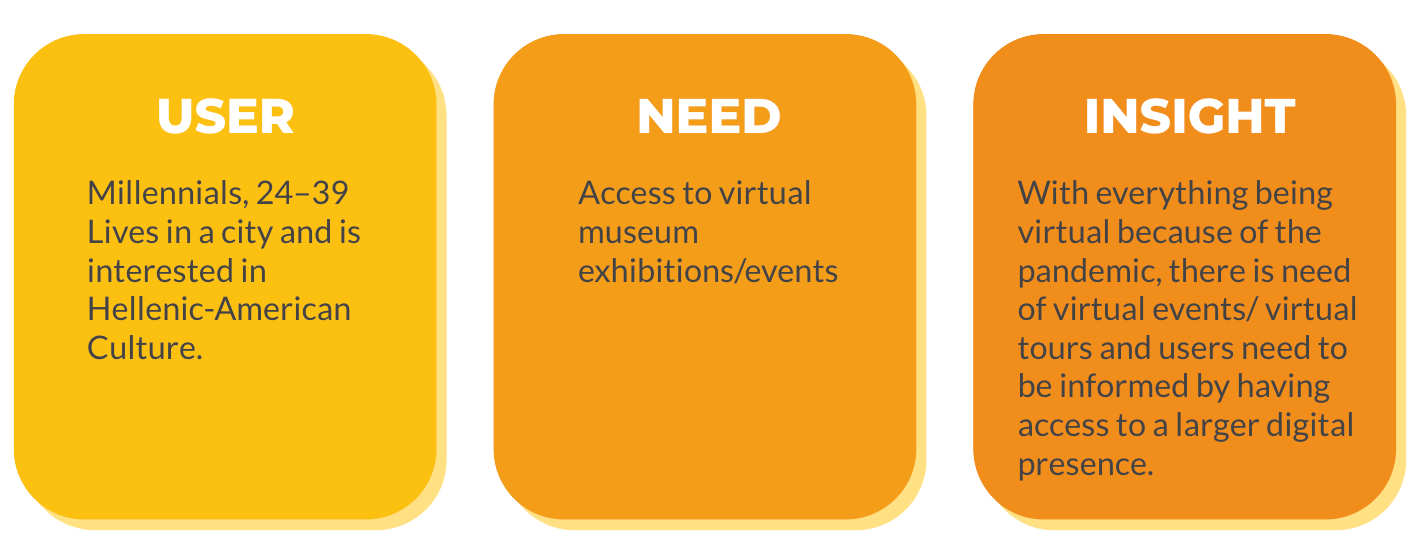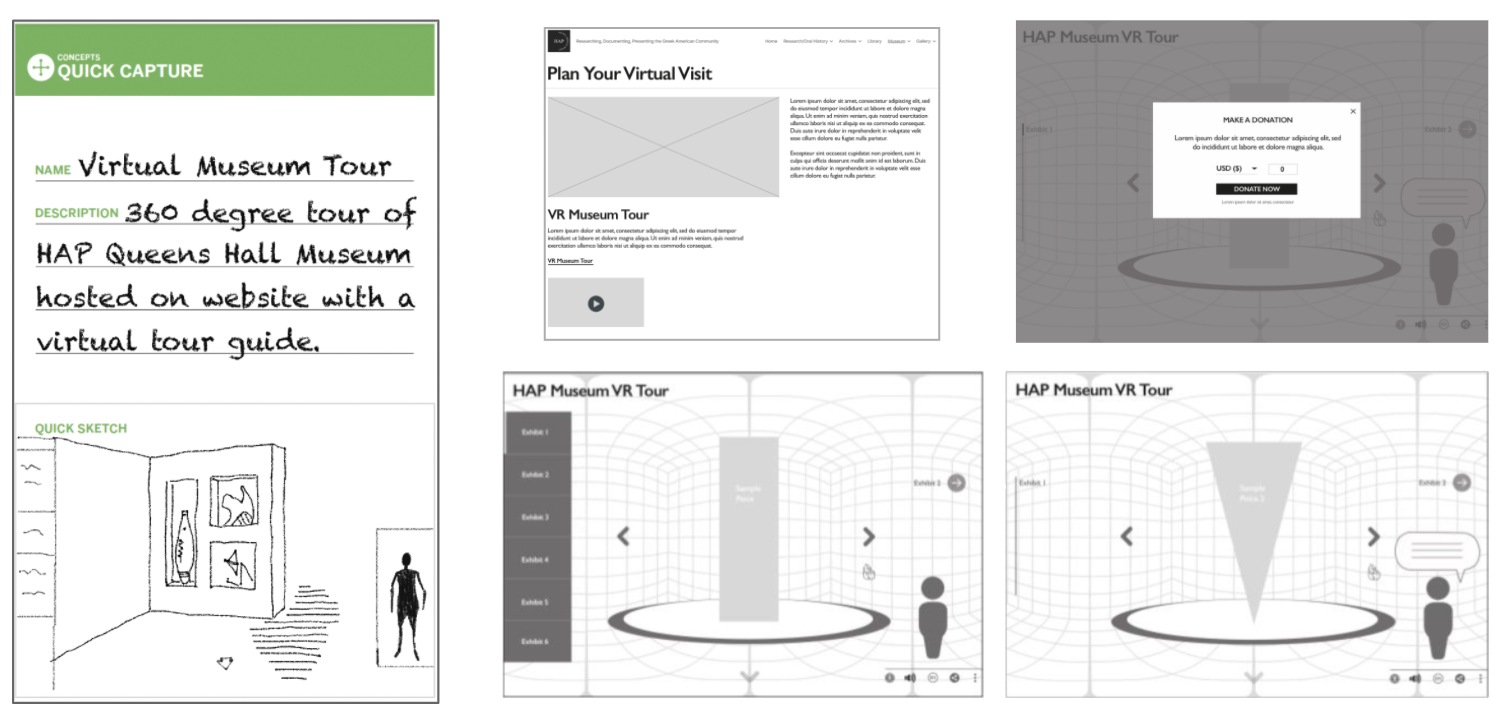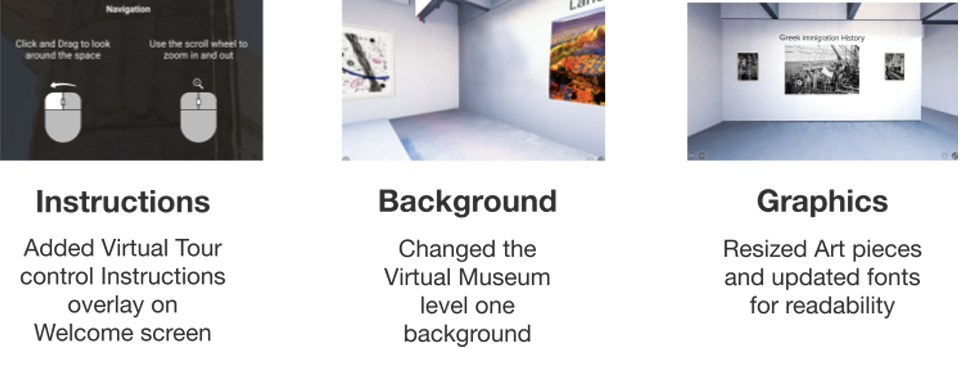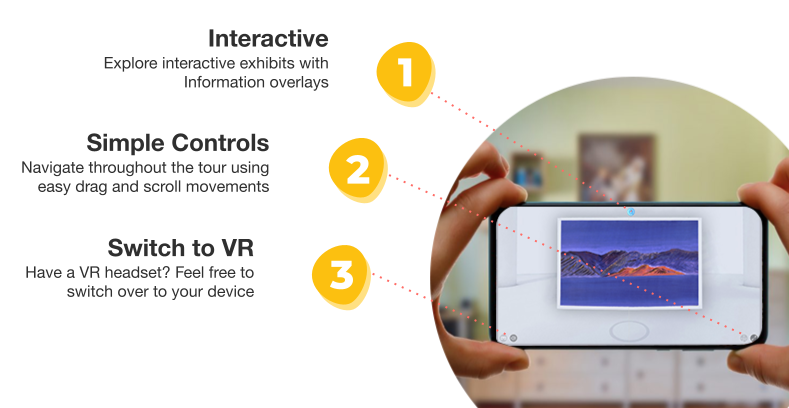
PROJECT DETAILS
Client Project l 14 WeeksAcross the world, many non-profit institutions remain closed. Their challenge is to encourage their audience to remain engaged with offerings of digital content. It almost seems like a losing proposition from the get-go but it’s vital to get back to normal levels.
Museums around the world have set up their exhibits in an online environment due to the pandemic. This shows the change that HAP will more or less have to undergo to continue serving the public. Currently all exhibits have either been closed or moved into an online format.
During this time, it is both difficult to host in a physical place and get funding since HAP is not well known to Millenials.
Role
Lead UX/UI DesignerTeam
Francesco TamayDeliverables
- UX Research
- User Journey & Persona
- Website site Landing Page
- Website User Flow
- Responsive High-Fi VR Prototype
About HAP
The Hellenic American Project is a multipurpose cultural center focusing on the development and diversity of Greek American people through oral history and the Arts. Located in Queens Hall at Queens College, they offer lectures, symposia, films, digital display and online catalogues complied with a modern eye.
Stakeholder Interview
After the interview with Nicholas, we clearly understood the problems that HAP was facing and from there we were able to synthesize opportunities that they could benefit them.
![]()
Design Process
![]()
After the interview with Nicholas, we clearly understood the problems that HAP was facing and from there we were able to synthesize opportunities that they could benefit them.
Design Toolkit

Design Process
Our POV
After rapid testing with a few of my collogues I updated my wireframes based on some reccomendations and created another LoFi prototype.

Solution
“The virtual museum experience responds in a multidimensional way to different needs that can be simultaneously educational, exceptional, social, leisure oriented or many others.” –Tiina Roppola, Designing for the Museum Visitor Experience
We aimed to use the HAP museum as a launching point for our Virtual Tour. On virtual tours, visitors often rejoice in autonomy. They can move freely in space through functionality (should work), reliability (should work well), usability (should be easy to use), proficiency (should enable people to do something better), and creativity (should enable people to envision something new).
Persona

Userflow
The user would receive the link to the virtual tour via email or simply by going on the HAP website. The tour would consist of exhibits that can be found on the HAP museum. One of the key features we included was a donation pay wall which presented itself at the start of the VR tour.
![]()
Concept/Wireframes
![]()
HiFi Design First Iteration
![]()
Research
GOALS
The purpose of the usability testing was to comprehend the overall impact of the environment and how all this assimilates for the user in the virtual environment
METHOD
The method for the usability testing was a full day of moderated 1:1 user interviews. We used InVision for the prototype and recorded our interviews.
PARTICIPANTS
Five participants were interviewed for the usability test. All of the participants were found by contacting people from each of the team members networks between the ages of 20 -30 years old.
1-on-1 Interview Findings
![]()
Research Quotes
“It was really nice to get, essentially a gallery experience with the convenience or comfort of my own home, or the location I choose.” —Participant 1
“It looks really nice, I like it. I didn’t know you could do something like this” —Participant 3
This is really cool. It is nice to have this museum environment digitally, in front of me”—Participant 4
“It was very smooth, very self explanatory and I really love the gallery experience”—Participant 5
HiFi Design Second Iteration
![]()
Improvements
![]()
Protoype Overview
![]()
Takeaways
Of course, many considerations are still open. Human needs are the same whether the means of delivery are live or online, but on the contrary people may not always be the same, as they may experience the same visit more than once and perceive (and behave) differently each time.
Other key issues to consider certainly remain: how to solicit social interactions between visitors, themselves or their friends, how to build long-term relationships between the museum and visitors and above all how to expand research on this investigation.
The user would receive the link to the virtual tour via email or simply by going on the HAP website. The tour would consist of exhibits that can be found on the HAP museum. One of the key features we included was a donation pay wall which presented itself at the start of the VR tour.

Concept/Wireframes

HiFi Design First Iteration

Research
GOALS
The purpose of the usability testing was to comprehend the overall impact of the environment and how all this assimilates for the user in the virtual environment
METHOD
The method for the usability testing was a full day of moderated 1:1 user interviews. We used InVision for the prototype and recorded our interviews.
PARTICIPANTS
Five participants were interviewed for the usability test. All of the participants were found by contacting people from each of the team members networks between the ages of 20 -30 years old.
1-on-1 Interview Findings
Research Quotes
“It was really nice to get, essentially a gallery experience with the convenience or comfort of my own home, or the location I choose.” —Participant 1
“It looks really nice, I like it. I didn’t know you could do something like this” —Participant 3
This is really cool. It is nice to have this museum environment digitally, in front of me”—Participant 4
“It was very smooth, very self explanatory and I really love the gallery experience”—Participant 5
HiFi Design Second Iteration

Improvements

Protoype Overview

Takeaways
Of course, many considerations are still open. Human needs are the same whether the means of delivery are live or online, but on the contrary people may not always be the same, as they may experience the same visit more than once and perceive (and behave) differently each time.
Other key issues to consider certainly remain: how to solicit social interactions between visitors, themselves or their friends, how to build long-term relationships between the museum and visitors and above all how to expand research on this investigation.